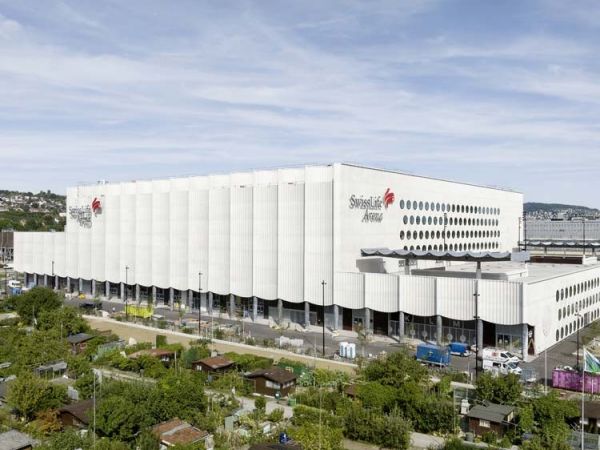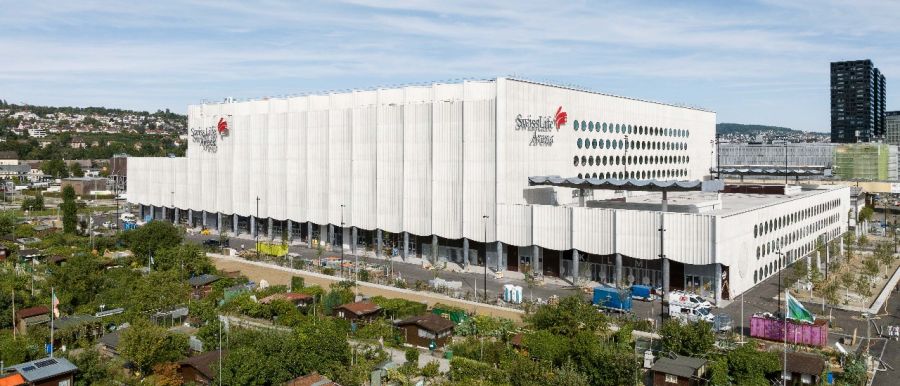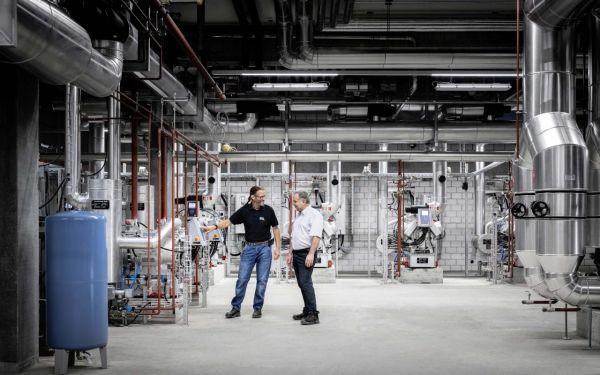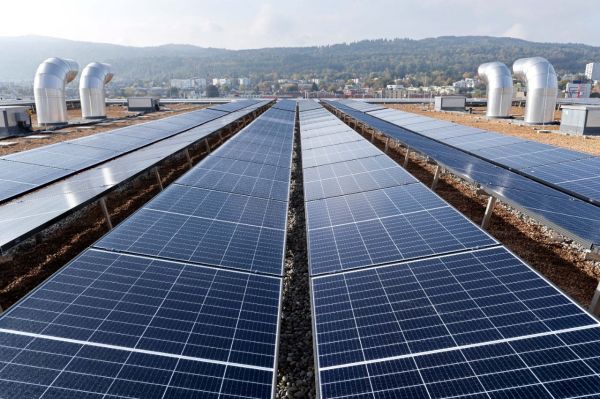

- 28,000 m² site
- Capacity for approx. 12,000 seats and standing places
- Heat requirement of 2.8 GWh per year
- Cooling requirement of 3.7 GWh per year, of which 2.6 GWh per year for ice rinks
- Cooling for adjoining cooling network 4.2 GWh per year
- Around 0.4 GWh per year of photovoltaic production
- 100 per cent carbon-neutral, Minergie certified
- Around 650 tons of CO₂ emissions avoided per year
The arena plays host to more than just hockey games. With its state-of-the-art and sustainable infrastructure, the multifunctional arena also hosts selected major non-ice hockey events and all kinds of corporate events too.
The new, 170-metre-long stadium in Zurich Altstetten also has a lot to offer from the outside. The unique exposed concrete façade, which looks like a draped curtain and was manufactured by the builder on site, is particularly eye-catching. It is not only a masterpiece of craftsmanship, but also had environmental benefits because long transport routes were eliminated and the added value remains in Switzerland.
Sustainability is a top priority, but not just for the facade. The energy concept for the Swiss Life Arena, with its floor space of 31,500 m2, was also developed based on the objectives of the 2,000-watt society. The integrated energy solution combines ecology and cost-effectiveness by skilfully exploiting synergies between cooling production and the resulting waste heat.
Ice rinks at the heart
The heart of the arena are the two central ice rinks. The training rink and main rink also form the core of the energy concept. The switch point for cooling and heat production is the energy centre, which we took over as a shell for further expansion in April 2021. This is where the cooling for the ice and the climate cooling for the dehumidification of the ambient air in the stadium is produced. Environmentally friendly ammonia is used as a refrigerant for the main rink, which ensures that the ice surface is very high quality. A water-glycol mixture flows through the pipes of the training rink.
Cooling is also required for dehumidifying rooms and for air conditioning. Humidity is always a problem during matches at ice rinks, because the stadium fills up quickly with spectators who release a lot of heat. Cooling is used to cool the humid air down to the dew point, the moisture is collected and drained away and the dry air is then reheated. This process is demand-driven and controlled by sensors. The ancillary rooms, such as the restaurant, conference rooms or physiotherapy rooms, are air-conditioned using a thermal component activation system. A piping system embedded into the walls and ceilings activates the building mass and is therefore able to control the temperature of these rooms in a gentle, draught-free way.

In the energy centre, we generate environmentally friendly cooling for the stadium and the surrounding office buildings. This ’cooling hub’ for third parties is an extremely worthwhile solution in view of the growing demand for cooling that is resulting from years of rising summer temperatures
When you produce cooling, you also generate heat - a welcome side effect. In the arena, we use the waste heat from ice production for heating. A heat pump prepares the hot water. A low-temperature network sends heat to the underfloor heating. We provide hot water and water for ice preparation via the high-temperature network.
Connecting the arena to the anergy network of the Altstetten cooling network enables loss-free energy management. If excess heat is generated from cooling, it is fed into the anergy network, which slightly raises the temperature. This sophisticated solution prevents waste heat from just being discharged through the roof unused. The anergy network transports heat to the local heating plants within the Altstetten energy network, where it is heated to the required temperature using heat pumps. When completed in 2035, around 30,000 households in the Altstetten and Höngg districts will be supplied with heat in this way.
Buildings and technology designed for energy efficiency
The linking of the energy and district cooling networks creates numerous synergies in the supply of environmentally friendly heating and cooling to the stadium and its surrounding areas.
The electricity consumed at the Swiss Life Arena is 100 per cent carbon-free and comes from renewable sources such as wind and water. A 400 KWp photovoltaic system is also installed on the roof. The electricity produced here is consumed directly in the arena. Electricity production is measured by meters every quarter of an hour and divided between the two recipients, the ZSC Stadium (stadium operation) and ewz (energy centre operation), according to current requirements.

The ZSC Arena and the ewz energy centre are supplied at medium voltage from the ewz distribution grid. Our Grid Services department concluded a contracting agreement with ZSC Immobilien AG that covers the construction, operation and financing of the high-voltage supply system for the arena. The transformer station is connected via a medium-voltage ring at the ewz substation, supplies the energy centre’s downstream medium-voltage system and includes energy metering, transforming to the customer’s low-voltage systems and connection to ewz’s control centre. A change in status or a malfunction can therefore be recorded 24/7. The ewz on-call service intervenes in an emergency.
However, it is not only the complex building services at the Swiss Life Arena that enables a high degree of energy efficiency. The architects designed the structure in such a way that it uses as few resources as possible during both construction and operation. Together with the sophisticated building services system, the Swiss Life Arena meets the Minergie standard for ice stadiums. The integrated building automation system, which ensures demand-driven control of the systems and efficient operation, also plays a key role in this.
One of the biggest challenges for us was the optimal coordination of the various building services components and the integration of the arena into the Altstetten energy network. We will ensure optimal operation of the building services facilities over a period of 30 years. A remote monitoring system also allows external access to the system.






